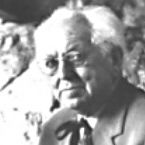Holzmeister, Clemens, b. Fulpmes (Tyrol), March 27, 1886, d. Hallein, June 12, 1983, architect. Studied at the University of Technology, taught at the Vienna Academy of Fine Arts (1924-1938, 1954-1957), head of workshops for master craftsmen at the Düsseldorf Academy of Art (1928-1932), president of the Central Association of Architects and of the new Austrian Werkbund (1932-1938), emigrated to Turkey (1938-1954). Awards include Grand Austrian State Prize 1953. Notable for his symbolic monumental and religious buildings. Transformed local building traditions by introducing new elements, a combination of simplicity and expressive gestures. Created also monuments and set designs.
Holzmeister in Turkey: The Austrian architect Clemens Holzmeister has a special place among prominent architects invited from foreign countries during the foundation years of the Turkish Republic. He was invited to Turkey in 1927 to execute the governmental buildings of the new capital. Having completed 13 buildings until 1936, and winning the international competition for the Turkish Grand National Assembly, Holzmeister attained the rank of ?official state architect?. He designed his first projects for Ankara as part of his international practice, while he was professor both at the Academy of Fine Arts in Vienna and the Prussian Academy of Fine Arts in Dusseldorf. In February 1938, he was commissioned by Atatürk himself to build the Parliament building . At the time, Hitler?s troops were on the verge of occupying Austria. As Holzmeister had supported the Austrian government, which fought for Austria?s independence against the Nazis, he was expelled from his post in Vienna. During World War II, Holzmeister joined hundreds of scientists and intellectuals who sought refuge in Turkey. In his new homeland between 1938-1954, he lived and worked in Istanbul and Ankara, contributing also to the education of architects at Istanbul Technical University. Holzmeister did not lose contact with Turkey throughout his life: his last visit to Ankara was in 1978 for the occasion of consulting on the enlargement of the Grand National Assembly complex.
Works: The Crematorium in Vienna ( 1921-1924) The Broadcasting Centre in Vienna (1935-39) The Festival Theatre in Salzburg ( 1st alteration 1926, 2nd alteration 1936/38) The Provincial Theatre in Linz ( 1953-1960 ) h The New Festival Theatre in Salzburg ( 1955-1960 )
Buildings in Ankara The Ministry of War & General Staff Building ( 1927-1930 ) The Ministry of Employment ( 1929-1934 ) The Military Academy and Officers' Mess Club ( 1930-1935 ) Atatürk's Palace ( 1931-1932) The Central Bank ( 1931-1933 ) The Security Memorial ( 1931-1936 in co-operation with the Austrian sculptor Anton Hanak ) Emlak-Bank (1933-1934 ) The Supreme Court ( 1933-1934 ) The Austrian Embassy ( 1933-1934 ) The Trade, Commerce and Agriculture Ministry ( 1933-1935 ) The Department of the Interior/ The Home Office ( 1932-1934 ) The Parliamentary Buildings / Houses of Parliament in Ankara ( 1938-1943 )
